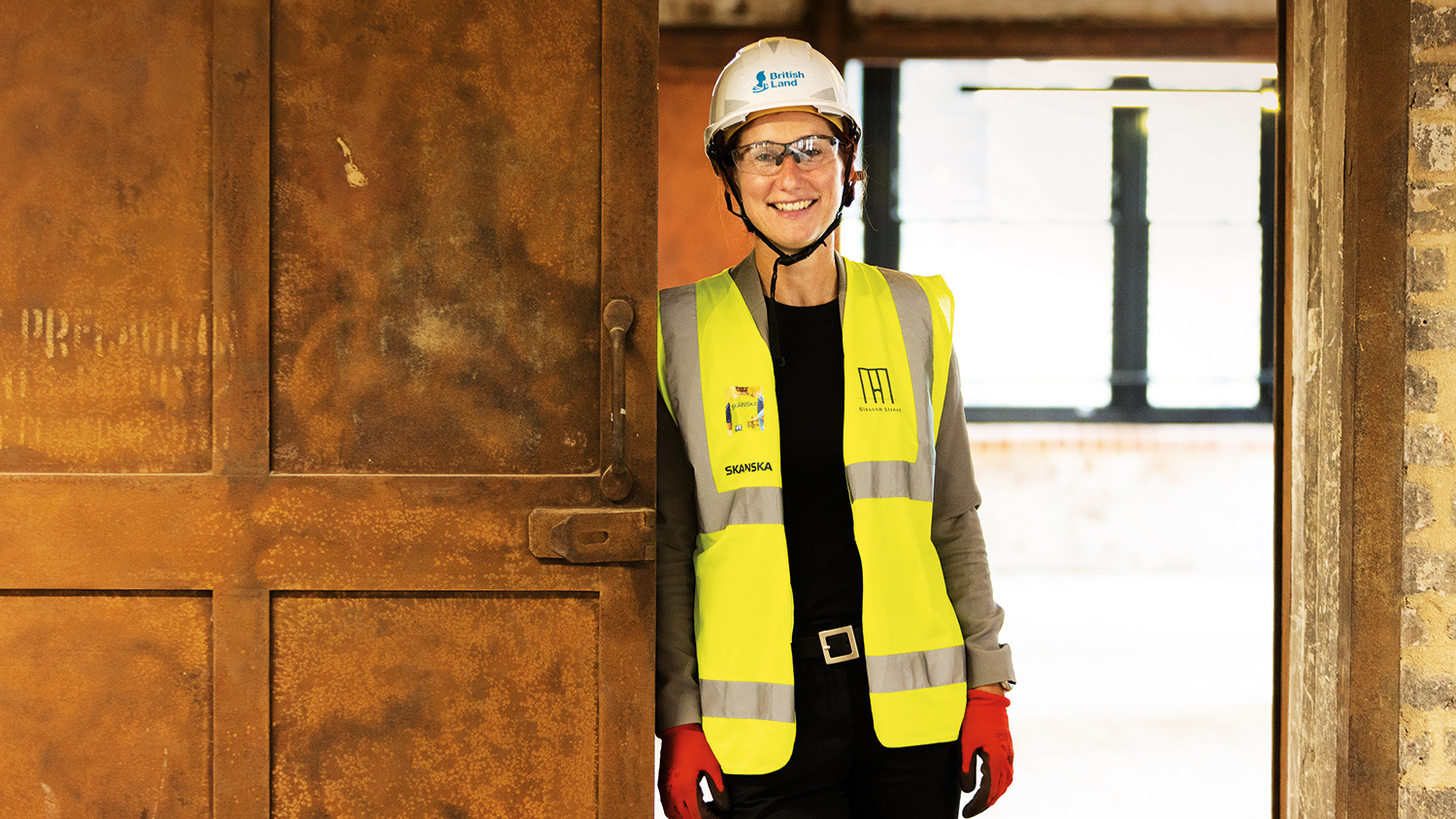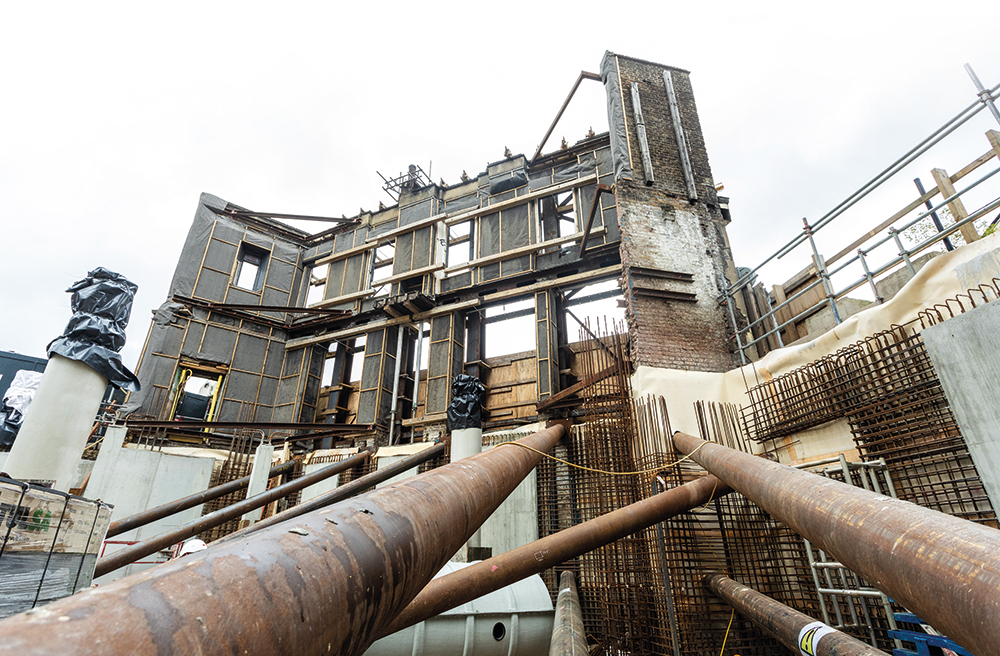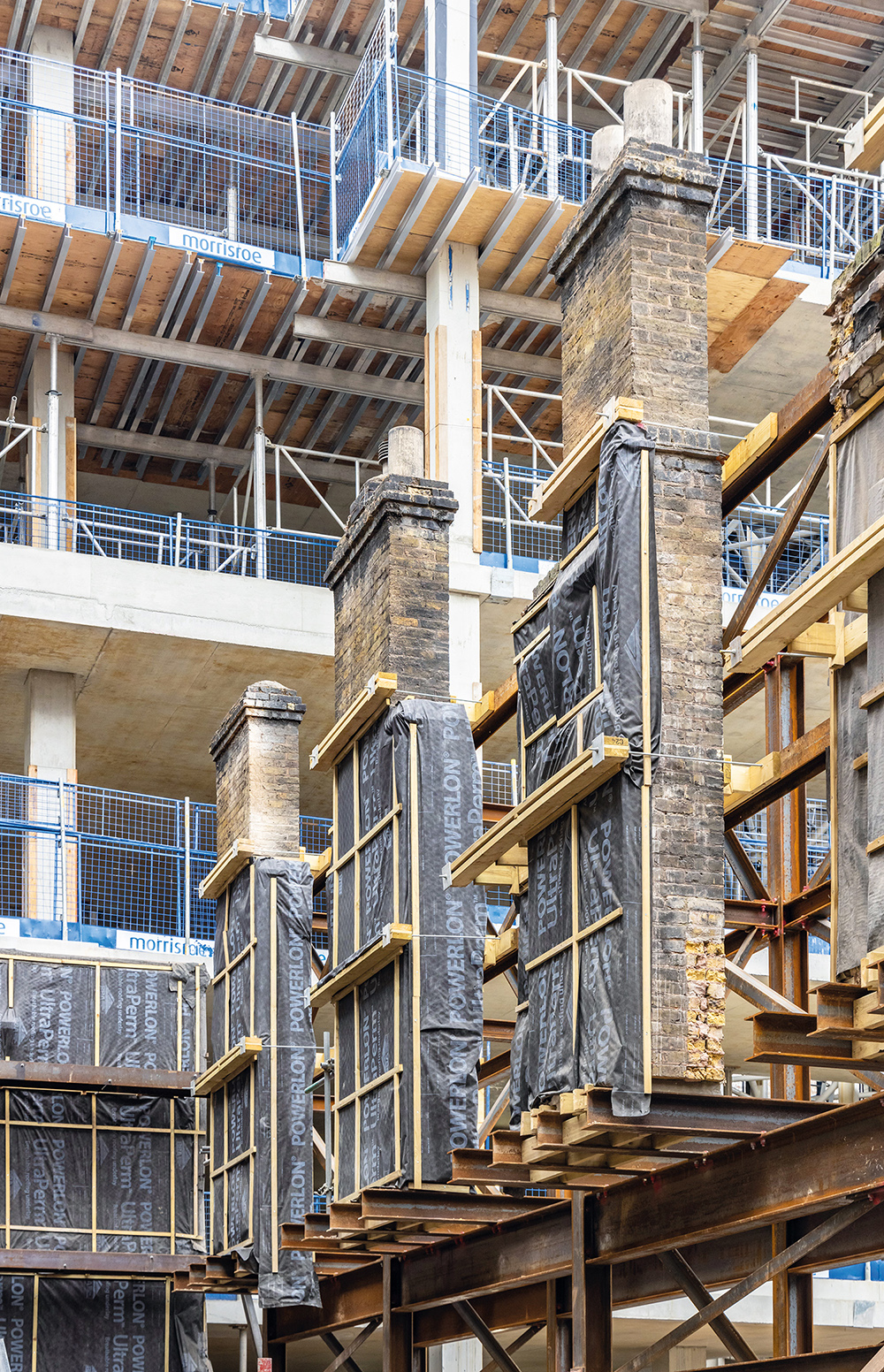
At Norton Folgate on the edge of the City, British Land is bidding to preserve the past while catering for the appetites of corporate office clients. Kristina Smith met the developer’s project director Lynn Summerfield.
Walking around the site at British Land’s Norton Folgate development, which lies between Liverpool Street and Shoreditch in east London, is somewhat disorientating. Led by British Land project director Lynn Summerfield FCIOB, we flit around the six different plots that make up this scheme, through buildings that are old, new, rebuilt or with retained facades.
“Every week I ask to walk around the site with someone different, and everyone has this bounce in their step because I think they know we’re doing something special,” says Summerfield.
Norton Folgate – Project details
Client: British Land
Project cost: £225m
Form of contract: JCT MPCC 2016
Start date (main works): January 2021
Completion: December 2023
Main contractor: Skanska
Project manager: M3 Consulting
Cost consultant: Alinea
Architects: AHMM, Stanton Williams, Morris+Company, DSDHA
Structural and civil engineer: AKT II
MEP engineer: Arup
Trade contractors
Concrete frame: AJ Morrisroe
Structural steelwork: Kilnbridge Construction Services
Glazing, cladding and roofing: Prater
Precast facade: Thorp Precast Concrete
Brickwork: Lyons and Annoot
Unitised cladding: Lindner Prater
Facade restoration: Paye Stonework & Restoration
It could just be that the bounce in Summerfield’s step is infectious. She is definitely a construction enthusiast, having learned her craft largely with Kier before moving to British Land in 2017, and it’s easy to see why this project enthuses her. There is a smorgasbord of different building ages, styles and technologies on this site, compounded by the fact that there are four architects – five, if you count the landscape architect – working on it, employed by British Land to bring a range of characters to the scheme.
Once complete, the development will provide 300,000 sq ft (27,870 sq m) of office space, 30,000 sq ft (2,790 sq m) of retail or food and drink and 15,000 sq ft (1,400 sq m) of public realm. The retained buildings are those that were considered of historic interest, not only those that are listed.

Within the development site, only the cobbles on Fleur de Lis Street are listed but there is local listing of buildings on Folgate and Elder Street. And the whole site sits within the Elder Street Conservation Area with the southern part of the site lying within the boundary of the scheduled ancient monument of the Priory and Hospital of St Mary Spital.
On paper, the additions to the site look somewhat overwhelming: high office blocks towering over the lower heritage buildings. On the ground, it seems to work. The scale feels human, with the new office space cleverly designed and located so as not to dominate. Streets and passages through the area will provide routes for members of the public to wander through and perhaps stop for a coffee.
Steeped in history
This area of east London, known as the Liberty of Norton Folgate, is steeped in history. Archaeology that took place during the enabling works unearthed a treasure trove of finds from Roman burials to medieval tiles reused in Tudor drains to cesspits.
When British Land applied for planning permission, there was considerable opposition to this scheme, led by the Spitalfields Trust which was set up to protect historic buildings in the area. A protest in 2015 saw some 500 people joining hands around the area. Tower Hamlets Council rejected the scheme, but was overruled by the then mayor of London, one Boris Johnson.

In response to consultation with local people and the Spitalfields Trust, the mayor of London required British Land to preserve more buildings than it had initially intended, says Summerfield. Most of the Victorian warehouses on Blossom Street, which runs through the centre of the scheme, were in poor repair before the project began, with some used occasionally for events. The oldest of these, built in 1887, is in the best condition and has been retained in its entirety – others in part or only the facades.
Short rows of existing buildings, predominantly Victorian with just one Georgian building, have been retained on roads bounding the scheme: Shoreditch High Street, Folgate Street and Elder Street. The Georgian building was in worse condition than anticipated.

“We wanted to keep it, but we found that the front facade was not connected to the dividing walls, so we ended up having to carefully take it down and rebuild it using the original materials,” explains Summerfield. A rather less visually pleasing 1970s office building, known as Loom Court, is also being updated. Originally earmarked for 40 residential units, this will now be an office.
Although Kier had initially been tipped to take the main works contract, following on from Cantillon which had an enabling works contract that included demolition and facade retention, British Land awarded it to Skanska in 2020, starting on site in 2021. There was speculation that this was due to Kier’s financial woes at the time.
Right track record
In selecting a contractor, British Land was looking for a company with the right track record and competence and the right values, says Summerfield. The core values of the scheme are her values, she says: being open and honest, having difficult conversations early and doing what’s right for the project, not what’s easy. The project team, including a project charter group made up from the client, contractor and some consultants, adopted those values.

One of the challenges for a project with so many elements – and hence so many consultants and contractors – is communication. To counter this issue, the team set up a system of half-hour updates for everyone: big information dumps over Teams to make sure everyone is up to date. “It’s one-directional but then the team can ask questions. We use an app so questions can be anonymous, which encourages people to ask them,” says Summerfield.
This is really several projects rolled into one, running concurrently and on top of each other. And each of the six plots has a section of retained building and a new build. “We are working across five or six plots all at the same time, all with their own rhythms and details,” says Skanska project director Graham Mercer. “The whole coordination piece was the biggest challenge.”
Skanska removed some onsite activity by replacing the significant amounts of hand-laid bricks required with precast panels. British Land had considered this approach, says Summerfield, but calculated that too much space would be lost and too much weight added. The solution was ultra-high-performance concrete (UHPC) from Thorp Precast Concrete, which meant the panels could be slimmer.
Added value from precast
As well as a 12-week time saving, using precast added other value too, says Mercer. Scaffold wasn’t needed, there were fewer people on site and fewer health and safety risks, as well as fewer vehicle movements in a congested and restricted area and assured quality. “In pounds per square metre terms it is more expensive but holistically it is cheaper,” says Mercer.

CV: Lynn Summerfield FCIOB
Lynn Summerfield FCIOB credits her father with her choice of career. “He was a head teacher and he brought me and my sister up to believe we could do anything we wanted to do.
I wanted to do something practical but academic and I spent all my time as a kid working on the house with my dad.”
After studying a building, management and technology degree at the University of Liverpool, Summerfield started work for Kier in 1999. Apart from a brief spell with BAM, she stayed with Kier until 2017, when she moved to British Land. She had acquired a taste for developing when, returning from parental leave, she was seconded to Argent LLP.
Aside from Norton Folgate, Summerfield’s most memorable project to date was the Sainsbury Laboratory for the University of Cambridge, which was built in the Botanic Gardens and went on to win the Stirling Prize for architecture. “That’s the project where I learned most about how to create a team that functions very well,” she says. “I learned a lot from the client and from the professional team there.”
That’s not to say that there are no bricklayers on site. There’s plenty for them to do, restoring, enhancing and adding to existing brickwork. One of Summerfield’s favourite details is a brick wall, rebuilt using engineering bricks faced with a brick slip cut from the existing bricks because the original bricks alone could not have taken the weight. Elsewhere beautiful old washhouse chimney breasts have been retained, propped up while the structure below them was demolished. An internal light yard in Blossom Yard is clad in a mixture of old and new white glazed bricks.
Aside from juggling restored and new-build structures, this project has thrown up some interesting issues related to building regulations and building services. For instance, fireproofing between floors of existing buildings has been a painstaking job. Airtightness standards for the old parts have sometimes been tricky to meet.
“There is a campus approach to the design of the building services for the scheme, designed by Arup,” explains Mercer. Basements have been created under two of the new buildings at Blossom Yard and Elder Yard to accommodate plant. Blossom Yard’s basement runs under Fleur de Lis Passage, requiring extensive propping and the reinstatement of the original paving after it was complete.
“This is far more challenging from an M&E perspective than a single new-build development,” says Mercer. The different layouts, technical requirements and lighting designs mean that there are many more products on the building services schedules.
Tomorrow’s occupants
One of the concerns from opposers to the Norton Folgate scheme was that this was yet another corporate development that would drive out small companies from the area.
British Land says that the variety of spaces mean that spaces could go to big or small firms – or both. And in the triangular corner of the Nicholls and Clarke building, once a sanitaryware firm, it will carry out a category B fit out and make the space available for shorter-term lets.
That said, the first big tenant signing has gone to law firm Reed Smith for one-third of the scheme’s total space, the majority of the 126,800 sq ft (11,780 sq m) Blossom Yard & Studios. Though some may complain that Norton Folgate’s latest rebirth has changed its character, it is the retention of character that makes it attractive. Companies which are vying for talent and looking for ways to attract staff into the office are looking for something more from their future working spaces.











